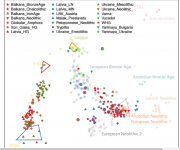Apsurdistan
Banned
- Messages
- 283
- Reaction score
- 62
- Points
- 0
- Ethnic group
- Bošnjak
- Y-DNA haplogroup
- I-Z63
- mtDNA haplogroup
- H5c
I don't see I1 anywhere, of course. It's basically non existent in ancient DNA before bronze age.
Follow along with the video below to see how to install our site as a web app on your home screen.

Note: This feature currently requires accessing the site using the built-in Safari browser.
The Olade et al admixture plot shows what looks to be about 35% for Yamnaya-Samara.I'm not sure about the Greek part.
None of the IE Package originated on the steppe except the domesticated horse and possibly the spoked wheel chariot.
All the models seem to put CHG "like" or "southern" ancestry at 40-50%
I don't see I1 anywhere, of course. It's basically non existent in ancient DNA before bronze age.
The ydna and mtdna are in Table 1. These are just some I noticed. There are some big surprises.
Iberia H/G 10,000 BC: J209:19179335T->C; IJ
126:21225770C->G
Harmonren Turkey 1 J1a
One J2 in LBK
Barcin 3 H2, 1J2a, 6 G2a2a1a2a, 1C1a2V20, 1 I2c, L596, 9 no result
Cardial, Croatia E1b1b1a1b1
Iron Gates Hunter- Gatherers: 3 R1b1a:A702:10038192G->A; R1b1a:CTS4244:15510064T->G; R1b1a:CTS8436:18026855G->A; R1b1a:FGC41:7900883C->A; R1b1a:L1345:21558298G->T; R1b1:CTS2229:14226692T->A; R1:CTS2565:14366723C->T; R:CTS8311:17930099C->A; R:FGC1168:15667208G->C;
One sample goes all the way back to about 10,000 BC. I wonder what Gioiello is doing. J
Lepinski Vir Neolithic 6222-5912 calBCE (7179±73* BP, OxA-25211)
: R1b1a:CTS4244:15510064T->G; R1b1:L822:7960019G->A; R:F652:23631629C->A; R:M799:23134896C->T
Greece Final Neolithic Kletios-G2a2a1a2
Greek Peloponnesus Neolithic- no results
Ukraine Mesolithic 8825-8561 BC- R1a
Ukraine “Neolithic”, which is much more WHG, has a lot of R1b1a
Globular Amphora is mostly I2, plus one each of:
BT CT
Varna: CT-I think this is the gold encrusted one, but someone check, R1, G2a2b2b, G2a
Tryphilia: 3 G2a2...…and one E
Smyadova Bulgaria 4545-4400 B C- 1 Late Chalcolithic R1b1a:A702, R P280:2184
Vucedol: R1b1a1a2a2, G2a2a1a2a
Croatia: EM Bronze-J2b
Can this be right? Ust-Isham 45530-40610 calBCE : R1a1a1b
And look at this: Iran Neolithic:
R:M718:17334694G->T
R:CTS2426:14300457G->A; R:FGC1168:15667208G->C
Now, my brain is fried.

Ah, so this Bronze Age Anatolia/Armenia invasion, that increased so much Caucasian admixture in Balkans, happened before IE invasion from North Europe to Balkans. Possibly this Anatolia invasion is IE Mycenaean and some others.
And what's the explanation for all the R1b in the Balkan hunter gatherers?
And what's the explanation for all the R1b in the Balkan hunter gatherers?
J2b was already in Sopot, so no surprise it's in Croatia, although I didn't check the subclades.
| I2a1 |
| R1a |
| R1b1a2 |
The refugium from which WHG derives seems to be in the southeast, not Franco- Cantabria. Only the small Goyets related ancestry in them would seem to come from FC. So much also for the thousands of words dedicated to trying to prove R1b was from Siberia or was EHG. The abuse meted out over this was incredible.The more interesting question is why some people thought R1b wouldn't be in the Balkan HGs :wink:
It's the place where it naturally would have piled up after spreading westwards from Iran-Anatolia at a time when travel along the northern route would have been significantly less pleasant than today.
The more interesting question is why some people thought R1b wouldn't be in the Balkan HGs :wink:
It's the place where it naturally would have piled up after spreading westwards from Iran-Anatolia at a time when travel along the northern route would have been significantly less pleasant than today.
I mean, when package was finished/collected and started to spread with steppe population.I'm not sure about the Greek part.
None of the IE Package originated on the steppe except the domesticated horse and possibly the spoked wheel chariot.
All the models seem to put CHG "like" or "southern" ancestry at 40-50%
Interesting to see J2b1a (L283) make its appearance in EMBA Croatia (c. 1600 BCE). I have linked that clade to the Indo-European migrations, but that is the first time is turns up in ancient samples.
This thread has been viewed 184976 times.
